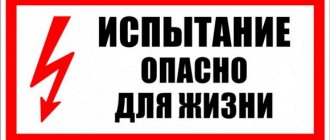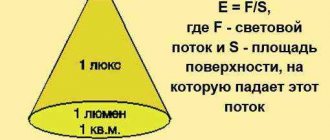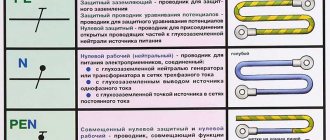Issues of electrical safety in production are only part of all activities and industrial safety requirements. Compliance with the requirements of numerous instructions and rules, ensuring safe working conditions is entrusted to the employer by the Labor Code of the Russian Federation. He is also responsible. Its extent depends on the severity of the consequences of violations or failure to comply with industrial safety and labor protection requirements. The head of an enterprise, especially if it is large, appoints employees responsible for compliance with occupational safety, fire and electrical safety requirements.
What conditions affect electrical safety?
There are many factors that increase the risk of electric shock. First of all, it is water. In its pure form, it is a dielectric, but salts and other impurities dissolved in it are excellent conductors of electricity. Since distilled water does not exist in nature, this liquid should be considered as conductive. Accordingly, a high concentration of water vapor, leading to the formation of condensate, increases the likelihood of breakdown on the electrical equipment housing, creates the threat of a short circuit and increases the risk of direct or indirect contact with live elements.
Electrical appliances that pose a hazard in the bathroom
No less dangerous is the high concentration of tiny conductive particles in the air. Such dust settles on current-carrying elements of equipment, forming conductor paths along which electricity can pass to various metal structures. As a result, there is a direct threat to the lives of operating personnel, not to mention equipment failure and more serious consequences.
Dust is no less dangerous than water
Dust also interferes with heat dissipation by covering electrical equipment housings or settling on ventilation grilles. This leads to a violation of the temperature regime, which can cause a serious accident.
Speaking of excessive heat, this is also a destructive factor that affects electrical safety. High temperatures contribute to early wear of current-carrying elements and destroy their insulating coating. What this can lead to was described above.
Active chemicals are also hazardous. At a certain concentration in the air, they practically “eat” the insulation from the wires, destroy the contacts of switching equipment and form conductive chemical compounds.
To reduce the influence of destructive factors, it is necessary to apply certain measures described in the electrical safety requirements. For this purpose, a system has been adopted for classifying premises according to the degree of danger, with a detailed description of the regulatory requirements for each group.
Which rooms, according to the PUE, are considered wet?
| Answer | Result |
| A mode that provides average values of its operating parameters | Incorrect answer |
| The mode in which the specified values of its operating parameters are ensured | Correct answer |
| The mode in which the maximum values of its operating parameters are ensured | Incorrect answer |
| Mode in which the minimum values of its operating parameters are ensured | Incorrect answer |
14. What, according to the Electrical Installation Rules, is called an independent power source?
| Answer | Result |
| A power source that maintains voltage in normal mode when it disappears from another or other power sources | Incorrect answer |
| A power source on which the voltage is maintained in post-emergency mode within regulated limits when it disappears from another or other power sources | Correct answer |
| Apparatus, unit, etc., designed for independent conversion of electrical energy into another type of energy | Incorrect answer |
| The electrical part of the power system that powers electrical energy receivers located in a certain area | Incorrect answer |
15. Which category, according to the Electrical Installation Rules, includes electrical receivers, the uninterrupted operation of which is necessary for an accident-free shutdown of production in order to prevent a threat to human life, explosions and fires?
| Answer | Result |
| To the first category | Incorrect answer |
| To a special group of the first category | Correct answer |
| To the second category | Incorrect answer |
| To the third category | Incorrect answer |
16. To what category, according to the Rules for the Construction of Electrical Installations, do electrical receivers belong, the interruption of power supply to which leads to a massive undersupply of products, massive downtime of workers, machinery and industrial transport, disruption of the normal activities of a significant number of urban and rural residents?
| Answer | Result |
| To the first category | Incorrect answer |
| To a special group of the first category | Incorrect answer |
| To the second category | Correct answer |
| To the third category | Incorrect answer |
17. What accuracy class should measuring instruments for measuring electrical quantities have?
| No worse than 1.0 |
| No worse than 1.5 |
| No worse than 2.5 |
| No worse than 3.0 |
18. What is a TN system for electrical installations with voltage up to 1 kV?
| A system in which the neutral protective and neutral working conductors are combined in one conductor along its entire length |
| A system in which the neutral of the power source is solidly grounded, and the open conductive parts of the electrical installation are connected to the solidly grounded neutral of the source via neutral protective conductors |
| A system in which the neutral of the power supply is isolated from earth or is grounded through high-resistance instruments or devices, and the exposed conductive parts of the electrical installation are grounded |
19. What is the TN-C system for electrical installations with voltages up to 1 kV?
| TN system, in which the neutral protective and neutral working conductors are combined in one conductor along its entire length |
| A system in which the neutral of the power source is solidly grounded, and the open conductive parts of the electrical installation are connected to the solidly grounded neutral of the source via neutral protective conductors |
| A system in which the neutral of the power supply is isolated from earth or is grounded through high-resistance instruments or devices, and the exposed conductive parts of the electrical installation are grounded |
| TN system in which the neutral protective and neutral working conductors are separated along its entire length |
20.What is the TN-S system for electrical installations with voltages up to 1 kV?
| TN system, in which the neutral protective and neutral working conductors are combined in one conductor along its entire length |
| A system in which the neutral of the power source is solidly grounded, and the open conductive parts of the electrical installation are connected to the solidly grounded neutral of the source via neutral protective conductors |
| A system in which the neutral of the power supply is isolated from earth or is grounded through high-resistance instruments or devices, and the exposed conductive parts of the electrical installation are grounded |
| TN system in which the neutral protective and neutral working conductors are separated along its entire length |
21. What is the TN-CS system for electrical installations with voltages up to 1 kV?
| TN system, in which the neutral protective and neutral working conductors are combined in one conductor along its entire length |
| A system in which the neutral of the power source is solidly grounded, and the open conductive parts of the electrical installation are connected to the solidly grounded neutral of the source via neutral protective conductors |
| TN system, in which the functions of the neutral protective and neutral working conductors are combined in one conductor in some part of it, starting from the power source |
| TN system in which the neutral protective and neutral working conductors are separated along its entire length |
22. What is an IT system for electrical installations with voltages up to 1 kV?
| TN system, in which the neutral protective and neutral working conductors are combined in one conductor along its entire length |
| A system in which the neutral of the power source is solidly grounded, and the open conductive parts of the electrical installation are connected to the solidly grounded neutral of the source via neutral protective conductors |
| A system in which the neutral of the power supply is isolated from earth or is grounded through high-resistance instruments or devices, and the exposed conductive parts of the electrical installation are grounded |
| TN system in which the neutral protective and neutral working conductors are separated along its entire length |
23. What is the TT system for electrical installations with voltages up to 1 kV?
| TN system, in which the neutral protective and neutral working conductors are combined in one conductor along its entire length |
| TN system in which the neutral protective and neutral working conductors are separated along its entire length |
| A system in which the neutral of the power supply is isolated from earth or is grounded through high-resistance instruments or devices, and the exposed conductive parts of the electrical installation are grounded |
| A system in which the neutral of the power source is solidly grounded, and the exposed conductive parts of the electrical installation are grounded using a grounding device electrically independent of the solidly grounded neutral of the source |
24. What is the definition of “Protection against direct contact”?
| Answer | Result |
| Protection against electric shock when touching exposed conductive parts that become live due to insulation failure | Incorrect answer |
| Protection of persons or animals from electrical contact with exposed conductive parts | Incorrect answer |
| Protection to prevent contact with live parts | Correct answer |
25. What is the definition of “Protection against indirect contact”?
| Answer | Result |
| Protection against electric shock when touching exposed conductive parts that become live due to insulation failure | Correct answer |
| Protection against voltage arising when current flows from the ground electrode into the ground between the point of current input into the ground electrode and the zero potential zone | Incorrect answer |
| Protection to prevent contact with live parts | Incorrect answer |
26. What is the definition of “Grounding”?
| Answer | Result |
| Conductive part not part of the electrical installation | Incorrect answer |
| A conductive part or a set of interconnected conductive parts that are in electrical contact with the ground directly or through an intermediate conducting medium | Correct answer |
| A third-party conductive part in electrical contact with earth, directly or through an intermediate conductive medium, used for grounding purposes | Incorrect answer |
27. What is the definition of “Artificial grounding”?
| Answer | Result |
| Grounding conductor specially designed for grounding purposes | Correct answer |
| Intentional electrical connection of any network point, electrical installation or equipment to a grounding device | Incorrect answer |
| A third-party conductive part in electrical contact with earth, directly or through an intermediate conductive medium, used for grounding purposes | Incorrect answer |
28. What is the definition of “Natural grounding”?
| Answer | Result |
| A conductive part or a set of interconnected conductive parts that are in electrical contact with the ground directly or through an intermediate conducting medium | Incorrect answer |
| Conductive part not part of the electrical installation | Incorrect answer |
| A third-party conductive part in electrical contact with earth, directly or through an intermediate conductive medium, used for grounding purposes | Correct answer |
29. What is the definition of “Grounding”?
| Answer | Result |
| A third-party conductive part in electrical contact with earth, directly or through an intermediate conductive medium, used for grounding purposes | Incorrect answer |
| Grounding of points of live parts of an electrical installation, performed to ensure the operation of the electrical installation | Incorrect answer |
| Intentional electrical connection of any network point, electrical installation or equipment to a grounding device | Correct answer |
30. What is the definition of “Protective grounding”?
| Answer | Result |
| Grounding for electrical safety purposes | Correct answer |
| Grounding of a point or points of live parts of an electrical installation, performed to ensure the operation of the electrical installation | Incorrect answer |
| Intentional electrical connection of any network point, electrical installation or equipment to a grounding device | Incorrect answer |
31. What is the definition of Basic Insulation?
| Answer | Result |
| Insulation in electrical installations with voltages up to 1 kV, providing a degree of protection against electric shock | Incorrect answer |
| Insulation of live parts, including protection from direct contact | Correct answer |
| Independent insulation in electrical installations with voltages up to 1 kV, for protection against indirect contact | Incorrect answer |
32. What is the definition of “Double Insulation”?
| Answer | Result |
| Insulation in electrical installations with voltage up to 1 kV, consisting of basic and additional insulation | Correct answer |
| Independent insulation in electrical installations with voltages up to 1 kV, performed in addition to the main insulation for protection against indirect contact | Incorrect answer |
| Insulation in electrical installations with voltages up to 1 kV, providing a degree of protection against electric shock equivalent to double insulation | Incorrect answer |
33. What is the definition of “Reinforced Insulation”?
| Answer | Result |
| Independent insulation in electrical installations with voltages up to 1 kV, performed in addition to the main insulation for protection against indirect contact | Incorrect answer |
| Insulation in electrical installations with voltages up to 1 kV, providing a degree of protection against electric shock equivalent to double insulation | Correct answer |
| Insulation in electrical installations with voltage up to 1 kV, consisting of basic and additional insulation | Incorrect answer |
34. Give the correct definition of the term “Extra-low (low) voltage (ELV)”.
| Answer | Result |
| Voltage not exceeding 50 V AC and 120 V DC | Correct answer |
| Voltage, more than 60 V AC and 220 V DC | Incorrect answer |
| Voltage not exceeding 70 V AC and 140 V DC | Incorrect answer |
35. What is the definition of “Protective electrical separation of circuits”?
| Answer | Result |
| Protective separation of electrical circuits in an electrical installation | Incorrect answer |
| Separating one electrical circuit from another using basic insulation and shielding | Incorrect answer |
| Separation of one electrical circuit from other circuits in electrical installations with voltage up to 1 kV using: double insulation, basic insulation and protective screen, reinforced insulation | Correct answer |
36. Are paint coatings insulating against electric shock?
| Answer | Result |
| Are not | Incorrect answer |
| Are | Incorrect answer |
| They are not, except in cases specifically stipulated by the technical specifications for specific products. | Correct answer |
37. What degree of protection should fences and shells have in electrical installations with voltages up to 1 kV?
⇐ Previous2Next ⇒
Recommended pages:
Classification
No matter how reliable the insulating coating is, it cannot last forever, especially when the technological cycle involves difficult conditions. Other factors can pose a threat, such as metal flooring in a production area or the location of electrical equipment near grounded metal structures. This, if touched indirectly, can cause electric shock.
To improve the efficiency of electrical safety, a system for classifying premises according to the degree of danger was developed. In accordance with current standards (see PUE clause 1.1.13), all types of premises (domestic, industrial, administrative, etc.) are divided into three groups. Each of them will be discussed in detail below.
First class - “premises without increased danger”
This group includes any type of premises that meets the following conditions:
- Low humidity, usually not exceeding 60.0%.
- The presence of climate control systems, including ventilation and heating, is allowed.
- The floor covering must be made only of dielectric materials. That is, earthen, reinforced concrete and metal floors are excluded.
- Air temperature up to 30.0°C.
- There is no release of process dust.
- There are no chemically active substances in the air.
That is, in the premises of this group it is unacceptable to have any destructive factors influencing a decrease in the level of electrical safety. Examples include premises in residential, office, retail and administrative buildings.
If the conditions listed above are met, production premises, for example, “clean” workshops where electronic components are produced, can also be included in this category. At such facilities, almost sterile conditions are created, a constant air temperature and a given level of humidity are maintained.
Production premises of the first class of electrical safety
Second class – “Premises with increased danger”
Any premises can be included in this group if at least one of the hazard factors inherent in this class is present. Let's list them:
- Increased moisture content in the air (over 75.0%). Detailed information about humidity standards can be found in the PUE (see paragraph 1.1.8).
- The presence of a large concentration of conductive dust generated during the technological process.
- The floor covering conducts electric current (reinforced concrete, metal, earth, etc.).
- The air temperature does not fall below 35.0°C. Permissible temperature standards for various classes of premises are given in the PUE (see clause 1.1.10).
- There is a risk of electric shock when indirectly touching live elements. For example, as a result of an insulation breakdown, dangerous voltage is present on the machine casing, and a grounded metal structure (column, beam, pipes, etc.) is located nearby. If the worker touches the structure and the casing at the same time, the worker will be exposed to lethal voltage.
Most of the production and repair shops, as well as some warehouses, fall under this category.
Third class – “Particularly dangerous premises”
There are three conditions, for any of which the premises can be classified as a category of special danger, list them:
- High moisture concentration, that is, relative humidity readings approaching 100.0%.
- Exceeding the permissible standards, the concentration in the air of chemically active compounds that can harm electrical equipment (destroy electrical insulation, contacts, current-carrying conductors, etc.).
- There is more than one factor from the list of conditions for the second hazard category in the premises. For example, high levels of temperature (from 35.0°C) and humidity (75.0% or more).
A striking example of a production facility that meets all three of the conditions listed above is galvanizing workshops.
Electroplating shop is a particularly dangerous room
It should be noted that according to electrical safety standards, open areas and areas located under a canopy are classified in the third category. Accordingly, this group includes any types of open switchgear (OSD).
Regulations
The Rules for the Construction of Electrical Installations (PUE) apply to all electrical installations under construction and reconstruction of alternating and direct current with a voltage of 750 kV and are mandatory, regardless of industry affiliation and form of ownership. The new, 7th edition is constantly updated as materials are processed and agreed upon with interested departments and approved by the ministry.
Nevertheless, experts argue that the publication does not cover the entire scope of the necessary changes, and probably in the near future the next updated edition of the PUE will be published.
Labor protection and fire safety requirements when working with electrical installations are also changing.
What is the danger?
First of all, there is a risk of electric shock, for example, high humidity leads to a shift in the dew point, as a result of which a water concentrate can form even at normal temperatures. Actually, for this reason, in any house or apartment the bathroom belongs to the 2nd category according to the standards of the accepted classification.
At temperatures above 35.0°C, the service life of the insulating coating of wires and other current-carrying elements is reduced. As a result, a “breakdown” may occur long before the end of the warranty period specified by the cable manufacturer.
Dust can cause a short circuit or cause equipment to overheat. Chemically active compounds also have destructive effects, destroying insulation and current-carrying elements.
To ensure the proper level of electrical safety in premises of the 2nd and 3rd classes, it is necessary to take a number of special measures, and almost all of them must be taken into account at the design stage of the facility.
Preface
Developed taking into account the requirements of state standards, building codes and regulations, recommendations of scientific and technical councils for reviewing draft chapters. The draft chapters were reviewed by the working groups of the Coordination Council for the revision of the EMP.
Prepared by JSC VNIIE.
Agreed in accordance with the established procedure with the Gosstroy of Russia, Gosgortekhnadzor of Russia, RAO UES of Russia (JSC VNIIE) and submitted for approval by Gosenergonadzor of the Ministry of Energy of Russia.
Approved by the Ministry of Energy of the Russian Federation, order dated July 8, 2002 N 204.
Chapter 1.1 of the Sixth Edition of the Electrical Installation Rules becomes invalid as of January 1, 2003.
“Rules for the construction of electrical installations” (PUE) of the seventh edition, due to the long period of processing, are issued and put into effect in separate sections and chapters as work on their revision, coordination and approval is completed.
The requirements of the Electrical Installation Rules are mandatory for all organizations, regardless of ownership and organizational and legal forms, as well as for individuals engaged in entrepreneurial activities without forming a legal entity.









